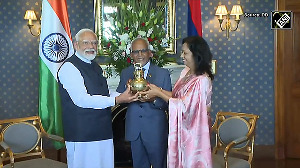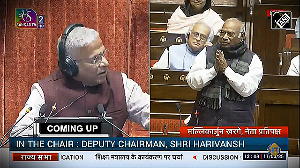Commercial, home, personal and car loans are sure to cost more with the Reserve Bank of India, under pressure to fight high inflation, today announcing stringent steps including raising mandatory cash reserves of banks to suck up over Rs 8,000 crore (Rs 80 billion).
Aimed at bringing down inflation from the present around 12 per cent to 7 per cent by March 2009, the central bank increased the Cash Reserve Ratio for the fourth time and raised short term lending rate to banks third time this fiscal.
In the quarterly monetary policy review, RBI increased CRR by 0.25 per cent to 9 per cent and short-term lending rate to banks or repo rate by 0.50 per cent to 9 per cent.
Lowering the growth projections for the economy to 8 per cent from the earlier 8-8.5 per cent, it targeted to bring down the rate of price rise to 7 per cent by March, making a clear case for prioritising inflation management over the GDP.
Floating rate
Floating rate home loan borrowers may have to brace up for another round of hike in their interest commitments. The repo rate hike will lead to a general rise in interest rates in the economy, at times leading to resetting of equated monthly installments on flexible home and personal loans.
Personal loans
The interest rates on personal loans too are likely to go through the roof, for it is expected that banks will pass on the burden to the consumders.
Car loan
With RBI hiking rates, your dream car may have become more expensive. Car loan lenders have jacked up interest rates on loans by anything between 75 to 100 basis points, and as a double whammy to you, even car manufacturers are increasing prices due to heavy input costs.
Earlier, RBI had set a goal of limiting inflation to 5-5.5 per cent. The new policy, which is sure to disappoint the industry that urged the RBI not to take steps that would make cost of credit higher, said that "the liquidity management will continue to receive priority in policy objectives."
Banking sources said that the RBI with its tight policy, being pursued since April this year, would have sucked up about Rs 50,000 crore (Rs 500 billion) of liquidity and there appears no let up in its hawkish stand during the rest of the year as it has forecast that hardening global crude prices would continue to exert pressure on the economy.
Besides the pressures from global commodity markets, the economy may also have to bear the burden of higher subsidies, loan waivers and increased salaries of government employees once the Sixth Pay Commission recommendations are implemented.
Within minutes of the announcement of RBI's measures, the finance ministry said the steps would help contain inflation but the banking sector, which was advocating for status-quo in credit policy, felt that lending rates to customers could go up by at least half a per cent.
RBI, however, admitted that "there are, however, some signs of moderation in key monetary and banking aggregates in response to monetary measures, which have withdrawn liquidity from the system and tightened interest rates across the term-structure."
The deepening financial turbulence in major financial centres has worsened the macro-economic outlook further by erosion of consumer and business sentiment and tightening of financing conditions with indications that a generalized credit squeeze may take hold, RBI said.
Given the current situation, the central bank said it was necessary to moderate monetary expansion and plan for a rate of money supply growth at around 17 per cent in 2008-09 in consonance with the outlook on growth and inflation so as to ensure macroeconomic and financial stability.
RBI left untouched the bank rate, the key lending rate to banks, and Reverse Repo rate, at which banks park their excess liquidity with central bank, at 6 per cent. The mid-term review of the annual policy will be announced on October 24.
It said the overriding priority of the monetary policy was to eschew any further intensification of inflationary pressures and to firmly anchor inflation expectations.
Interest rates set to harden: Bankers
The bankers on Tuesday said both lending and deposit rates are likely to go up by a minimum of 0.5 per cent, as a fall out of Reserve Bank today announcing a hike in short-term lending rate and cash reserve requirement of banks.
"We have to assess what is the actual impact and a decision would be taken accordingly. A minimum 0.5 per cent hike in our BPLR and deposit rates cannot be ruled out," state-owned Punjab National Bank's chairman and managing director K C Chakarabarty said.
Union Bank of India's chairman and managing director M V Nair said the bank's Asset Liability Committee would look at the liquidity condition of the bank after the hike.
The lender is likely to up its BPLR, Nair said, but did not say what would be the range of revision.
"Our ALCO will meet soon to assess the impact. There is a clear pressure on the profitability of banks after the present hikes in RBI key-rates. We may revise our BPLR upwards," Nair said.
Bank of Baroda's chairman and managing director M D Mallya said RBI's tone has been cautious about credit expansion given the present economic conditions, but the hike in CRR and Repo has caused an upward pressure on interest rates.
"Though it is too early to comment on whether BoB will hike its BPLR, there is an upward pressure on our interest rates," Mallya said.
However, he ruled out an immediate hike in BoB's deposit rates as it had increased its rates only recently.
Echoing a similar view, Kotak Mahindra Bank's Group Head, Retail liabilities, K V S Manian said the 0.5 per cent hike in Repo rate has come as a signal to the industry, which would push up the borrowing costs.
"If this (hike in Repo) is a signal, we have to see how the market is responding to that. We would like to watch the market movements and take decisions accordingly," Manian said.
He also said that there exists a visible upward pressure on the interest rates of the bank both on the asset and liability side.
RBI tightens more than expected: Goldman
The Reserve Bank of India's move to hike repo rate by 50 bps and the cash reserve ratio by 25 bps was stronger than expected, said Goldman Sachs in a statement.
'With this tightening, the central bank has come out strongly against inflation. The move continues the RBI's objective to get ahead of expectations and slow demand. We expect banks to pass on these increases to lending rates. In the accompanying statement, the RBI stated its objective to bring inflation down to 7 per cent by March 2009. This is an increase over its earlier target of 5.5 per cent. It also reduced its growth projection from the range of 8-8.5 per cent to 'around 8 per cent,' said the statement.
'We think that much higher interest rates will slow investment demand and growth, with the impact felt particularly in FY10. We have recently lowered our GDP growth forecasts for FY10 to 7.2 per cent from 8.2 per cent due to a weaker investment outlook, caused by much higher interest rates,' said Goldman Sachs.






 © 2025
© 2025